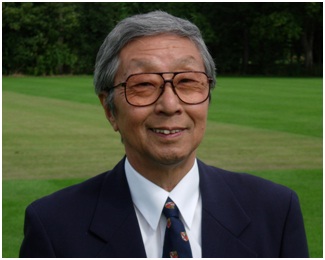No Events upcoming


Search
Event Reports
- 2015-03-28 09:00
- 2014-07-09 05:30
- 2013-09-25 09:00
User login
In Memoriam Ryozo Tanaka
 Ryozo Tanaka-san
Ryozo Tanaka-san
We have the sad duty of reporting the death of a valued member and a dear friend of many of us, Prof. Ryozo Tanaka, professor emeritus of Keio University. He passed away on July 29th, 2010, a month short of his 76th birthday, after only a brief spell in hospital. The funeral was a private family one, but a memorial event (shinobu-kai) was held at the Tokyo Club on September 13th for members of the Cambridge and Oxford Society to pay tribute to Prof. Tanaka and express their condolences to Mrs. Shigeko Tanaka and their granddaughter Hisako. A table was filled with Ryozo’s books, or books with which he had helped or in which he was mentioned, and in addition to a fairly recent portrait, there was a 1958 honeymoon photograph of a very young couple on the steps of Osaka Castle.
Ryozo Tanaka graduated in English literature from the graduate school of Keio University in 1963. His first visit to Britain was in 1968, when he led a group of university students. He subsequently studied English literature and philology at Cambridge University (1973-75). This was the first of many visits to Cambridge, where he was attached to Darwin College; taking a new direction, in 1987 and 1996 he studied architecture and art history, including country houses, under Dr. David Watkin. During these various visits his interest in English country houses had been stimulated, and he visited 300 of them in all. As professor of English at Keio University he used Evelyn Waugh’s novels as textbooks, and after his retirement in 2000 he continued to teach at three other universities. As a result of his studies of country houses he added the history of British and European art to his main subject. He was also chairman of the board of his old school, Azabu, and held this position for eight years until his retirement at the age of 70. During his tenure an exchange scheme of boys between Azabu and Winchester was established.
He will be remembered in Japan as one of the first Japanese to introduce British country houses to this country through his publications. Of his six major works, his magnum opus, literally so, as it is a hefty coffee-table- sized volume of 267 pages, is “Eikoku Kizoku no Yakata: The Country House” (Kodansha, 1992). In it, the descriptions of many country houses are accompanied by magnificent double-page photographs taken by his collaborator Akihisa Masuda. He also gave illustrated lectures on this subject, for example at meetings of the Japan-British Society, where his lively presentations provided a sharp contrast to his natural shyness and reserve.
Ryozo Tanaka was also a valued and active behind-the-scenes member of the Asiatic Society of Japan. He actually joined only in 2003, but he faithfully supported Shigeko (who had joined in 1981) in all her activities on behalf of the Society, of which she is now a vice-president. He also accompanied Shigeko on the various journeys she made in pursuit of her own research into the early trade in Japanese ceramics; she discovered some of them, kept as old family treasures, in the same stately homes to which his own studies had given them both access.
The gathering on September 13th was well attended, even though many people were barely back from their summer activities. Speech-making was kept to a judicious level, in keeping with the relaxed atmosphere of the occasion. The honorary secretaries, Tim Minton and Teruhisa Nakamura, began with their own memories of Ryozo. They were followed by former British Ambassador Sir Stephen Gomersall, who happened to be in Japan at that point and was able to stand in for the present Ambassador David Warren, who had put in a brief appearance at the beginning before having to leave for another engagement. Sir Stephen remarked with a twinkle that Ryozo had been present at so many events at the embassy that they had begun to think that he lived in a small room somewhere in the residence!
Later in the evening, others were invited to share their memories, and Doreen Simmons voiced the thoughts of many as she spoke of Ryozo’s devoted behind-the-scenes contribution to the success of so many ASJ meetings, ferrying refreshments from home and getting them ready. Those sitting at the back of the room would hear, towards the end of each talk, the sound of corks popping in the corridor outside as Ryozo judged the time was ripe to allow the wine to ‘breathe’. On one occasion it was discovered before a meeting began that the venue, an embassy hosting us for the first time, did not have a slide projector. Ryozo got into his car and first drove home to pick up his own small projector as insurance; then on to two universities, eventually arriving back at the embassy in the nick of time with three slide projectors! The talk, complete with slides, was a success, and hardly anybody realized how far Ryozo had gone out of his way to help. This was, indeed, typical of this quiet and unassuming man.
At the close of the evening Shigeko, in thanking all those present for coming, recalled many of her happy memories. To give her the final word, in a letter which she handed out to everyone as they left, she spoke of Ryozo as “a loving husband, a good father, and a doting grandfather. We all miss him very much.”
[Note: this is an adaptation of a tribute first published in the Bulletin of the Asiatic Society of Japan, written by Prof. Hugh Wilkinson and Doreen Simmons in honour of a fellow-Cantabrigian.]
Posted in Members only | Obituaries Submitted by huw.williams on Tue, 2010-11-09 02:44.
login to post comments
login to post comments